women Hair transplant against hair loss
Women can also have hereditary hair loss and consider hair transplantation. When thinking of baldness, many people associate it primarily with men. However, the female sex is also increasingly affected by hereditary (androgenetic) hair loss. Many suffer greatly from the consequences of hereditary hair loss, because hardly any woman wants to settle for a thinning hairstyle/hair situation or increasingly large receding hairline. Read here how a hair transplant with the FUE or FUT method can provide fuller hair, eliminate corners and even a high forehead and what the costs are for a procedure.
Female hair loss in general
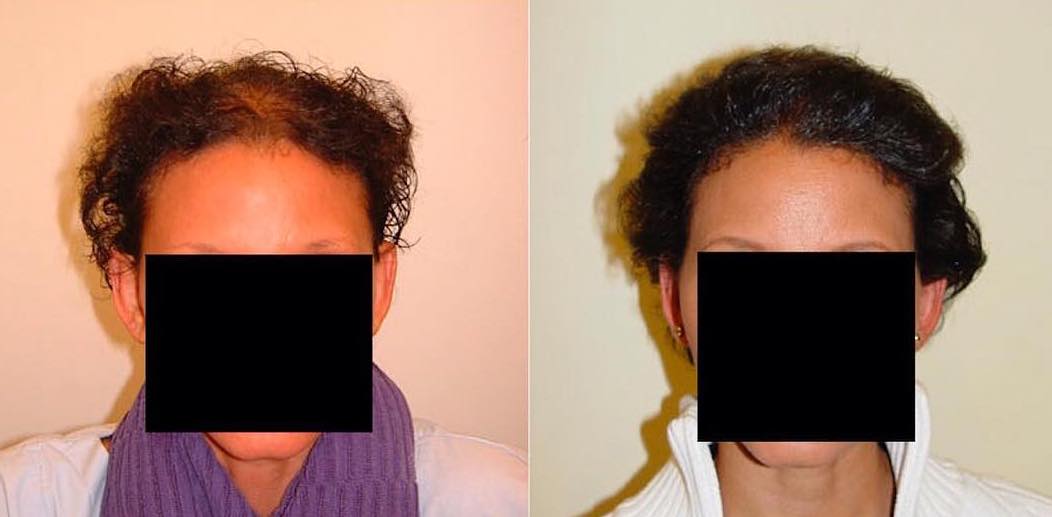
Hair loss is usually hereditary, although it can also be caused by illness (e.g. diabetes, thyroid disease, etc.) or hormonal changes. As a result, hair often becomes thinner and also falls out – “thinning out”, as FOCUS also reports regarding hair loss in women.1
However, the pattern of hair loss tends to follow the “Ludwig course” (Ludwig scale). The first signs are therefore usually in the crown region, above the ears, or thinning at the hairline of the forehead. Often, treatment with medication can help, e.g. dermatologists like to prescribe the active ingredient Minoxidil. If this does not have any effect, you can expect help from a female hair transplant! In this case, the planning and procedure is somewhat different; in many cases, comparatively greater hair density leads to the best aesthetic result. However, the results can be just as convincing as with men.
By the way, the reasons for hair loss in the female sex are very complex and it often requires a detective approach to actually get to the bottom of the real causes.
Here is an overview of some of the causes:
- Diseases of the skin
- Iron deficiency
- Problems with the thyroid gland
- Pregnancy
- Psychological stress
- Taking medication
- hormonal changes
Why are more and more women opting for hair transplants with the FUE or FUT technique (strip removal)?
Especially for women, aesthetics is often an important issue. A very important factor for an attractive appearance for women is strong and full hair. Beautiful full hair also stands for femininity. However, along with the hair, a piece of femininity and attractiveness is often lost, which is the most common reason for considering a female hair transplant with the FUE hair transplant or FUT technique (strip removal).
The good news:
Of course, the female gender can also undergo hair transplantation and surgical hair thickening, as recently also reported, for example, by Gala Online about Kim Gloss’ transplantation.2
However, the prerequisite for this is: A confirmed diagnosis of androgenetic alopecia (hereditary hair loss, AGA) and a well-preserved hair crown!
Hair transplantation women statistics: How high is the proportion of female clients for hair surgery?

In 2019, the proportion of women in all hair surgery procedures performed was 15.8% 3
A hair transplant in women to remove the receding hairline, to have the hairline lowered, or to increase the hair density in still hairy areas
If the diagnosis of androgenic alopecia is confirmed and if there is sufficient hair growth in the donor area, then hair transplantation can be performed.
In a female hair transplant, hair follicles are always “transplanted”, either into existing thinning areas for increasing the density, or into completely bald areas such as into the receding hairline, or to lower a hairline and reduce a high forehead.
In this case, the background knowledge is used that the hair follicles in the donor area are resistant to the harmful male hormones and thus the transplanted hair retains this insensitivity in the new area and never falls out again. The new hair will grow forever and will never fall out again (provided that you do not suffer from an illness at some point and lose your hair as a result, or hair loss as a result of taking medication, etc.).
“Many of the illegal clinics have fancy websites with references and testimonials that look very professional. However, the reality is that many patients have already had a bad experience and the hair transplant may even be performed by someone who has no medical training.”
Read more about the ISHRS.org “Fight The Fight” campaign

Campaign against illegal “black market clinics” World Association for Hair Surgery ISHRS.org
Hair Transplant Women: Two successful result examples
Hair transplantation to increase the density in a thinned out area
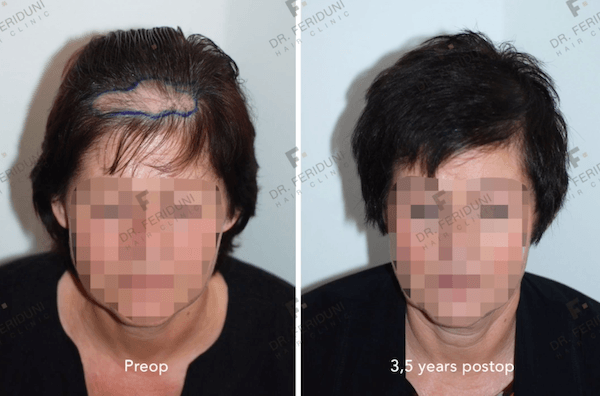
Hair transplantation of the receding hairline
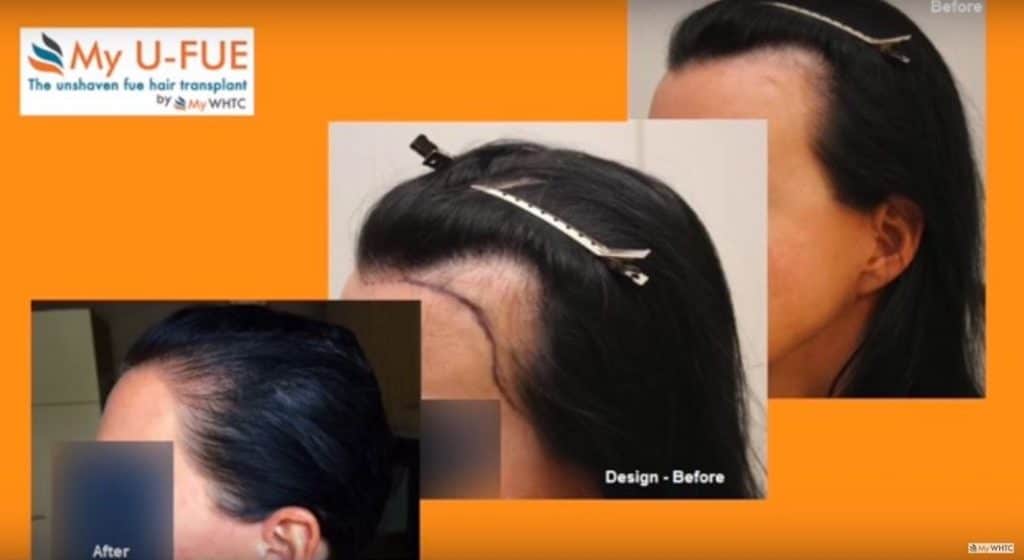
Hair transplantation of a high forehead in women: Forehead reductions through SHA surgery and/or advancement of the higher hairline
However, if you as a woman do not suffer from hair loss and “only” want to reduce a high forehead by lowering the hairline with a hair transplant, then this is of course also an option.
Not only can a deeper hairline and more hair volume be achieved through transplantation, but the female clientele also has the advantage that the status of a fully bald head does not usually occur, and therefore considerably higher densities can usually be achieved.
In the case of a high forehead in women, there is basically the possibility of transplanting one’s own hair, but also of moving the hairline using a surgical intervention and thereby reducing the forehead, a so-called Surgical Hairline Advancement – SHA (surgical hairline advancement) or the procedures can also be combined, as shown in the example of Dr. Feriduni, or also in the repair example of Dr. Feriduni.4
What is SHA?
SHA is a one-step procedure that allows the entire forehead hairline to be advanced by 1.5 to 5 cm through a trichophytic (hairline) incision. The advancement of the hairline allows for the corresponding removal of the forehead skin, thus shortening the height of the entire forehead. The extent of the lowering, the virtually immediate result and density of the advanced hairline, as well as the ability to aesthetically raise the eyebrows if desired, compares favorably to autologous hair transplantation.5 It was first popularised by Dr Sheldon Kabaker,6 but a decreasing number of hair surgeons are familiar with it, possibly due to the success of follicular unit transplantation and the move to minimal surgery.7
To be a good candidate, according to Dr Jeffrey Epstein and Dr Ashlin Alexander of New York, USA, the patient must have sufficient scalp mobility to achieve the desired degree of advancement, good frontal hair density, and no history of previous scalp surgery, such as a brow lift, that could compromise healing.5 A stable frontal hairline is an absolute must, as progressive hair loss could expose the incision scar at the hairline. In addition, these unstable hair along the hairline are particularly susceptible to shock loss, undoing the gains made by advancement.5
Would you like to be socially fit again quickly after your hair transplant?
Read more about Unshaven surgery for women and men!
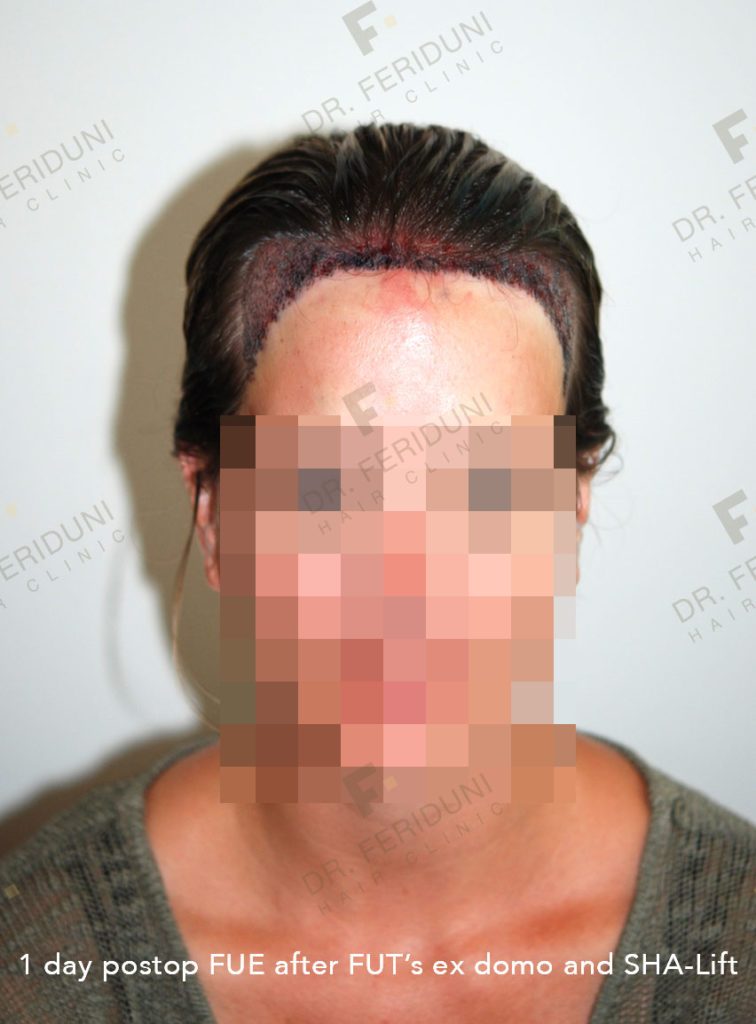
High forehead and example of a combination of surgical forehead reduction with SHA and subsequent strip hair transplantation with 1790 grafts by Dr. Bijan Feriduni: Video and pictures
Video
Pictures

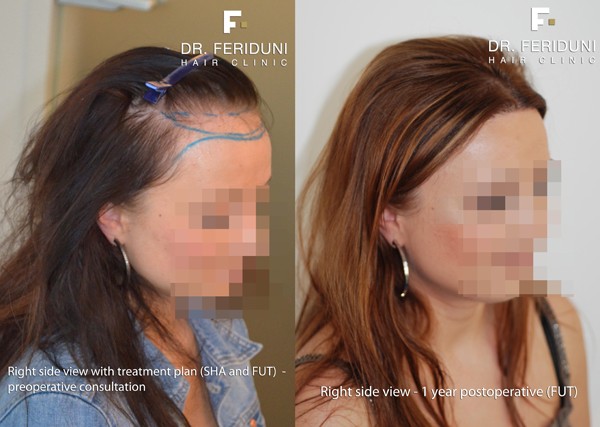
Repair case of Dr. Bijan Feriduni: Combination of SHA-lift, scar correction, and aN FUE without shaving – shaving of the receiving zone and strip shaving in the donor
A good hair transplantation requires a lot of experience and fine work! In the case of a female hair transplant, there are some additional necessary experiences, such as experience regarding design and the formation of female hairlines.
If the hairline is “designed” incorrectly in a female hair transplant and other mistakes are made, such as the new hair being placed in the wrong direction of growth, or if too many follicular units with several hair are transplanted in the front at the base (multiple FUs) and if, on top of that, only an insufficient density is transplanted (not transplanted with Dense Packing ), then – as experience shows – the results in women can end in an aesthetic disaster and, above all, in a long period of psychological depression for the patients concerned. Because especially for female patients, aesthetics play an important role and the aim was to improve the hair situation, the desire for more beautiful fuller hair, a deeper, natural, and dense hairline, and a more attractive and better overall appearance.
However, if a poor result is achieved with a transplantation by an insufficiently experienced doctor, then the disappointment is great, one is downright desperate and the patients often go psychologically on the gums for months
Below we would like to present a repair case of Dr. Bijan Feriduni (German doctor), a 32-year-old patient who had had a very bad experience before the repair:
The experience of a Caucasian 32-year-old woman: Repair of a bad hair transplant with the combination of a surgical hairline shift with SHA, correction of the scar and filling of the hairline, and receding hairline with FUE without shaving (shaving) the recipient area
Key data of the patient
- Patient 32 years old and from Caucasus
- 2 performed surgeries with the FUT method and bad experiences at another clinic
- Donor density of 84 FU/cm2 occipital, 84 FU/cm2 parietal, 76 FU/cm2 temporal
- Hair diameter of ~ 52-62 micrometres
Treatment plan
- SHA lift to lower the hairline and extract the misplaced and misaligned FUs from the previous hair transplants in the hairline and secretive corners
- Follicular Unit Extraction (FUE) into the hairline and receding hairline to achieve an aesthetic reconstruction of the hairline
- Scar correction of previous bad FUT procedures with Trichophytjc Close
Procedures performed
1. SHA lift + removal of misaligned and misplaced grafts(25 February 2019)
2. Scar correction with Trichophytic-Closure closure technique + FUE (Follicular Unit Extraction) with 1581 FU (14 August 2019) Follicular Unit Extraction without shortcutting/shaving of existing hair in the front and with a small strip shave in the donor area, with 1581 grafts/FU`s of which 639 single hair grafts, 613 double hair grafts and 329 triple and quadruple hair grafts, follicular density of grafts on average 1.9
Parallel incisions with the custom-size blades technique.
Extraction using the WAW system with a 0.85 mm serrated trumpet punch
The surgery was performed by the Hairforlife cooperation clinic Feriduni Hairclinic in Hasselt, Belgium
The women’s repair hair transplantation by Dr. Feriduni as video and in pictures
Video
Pictures




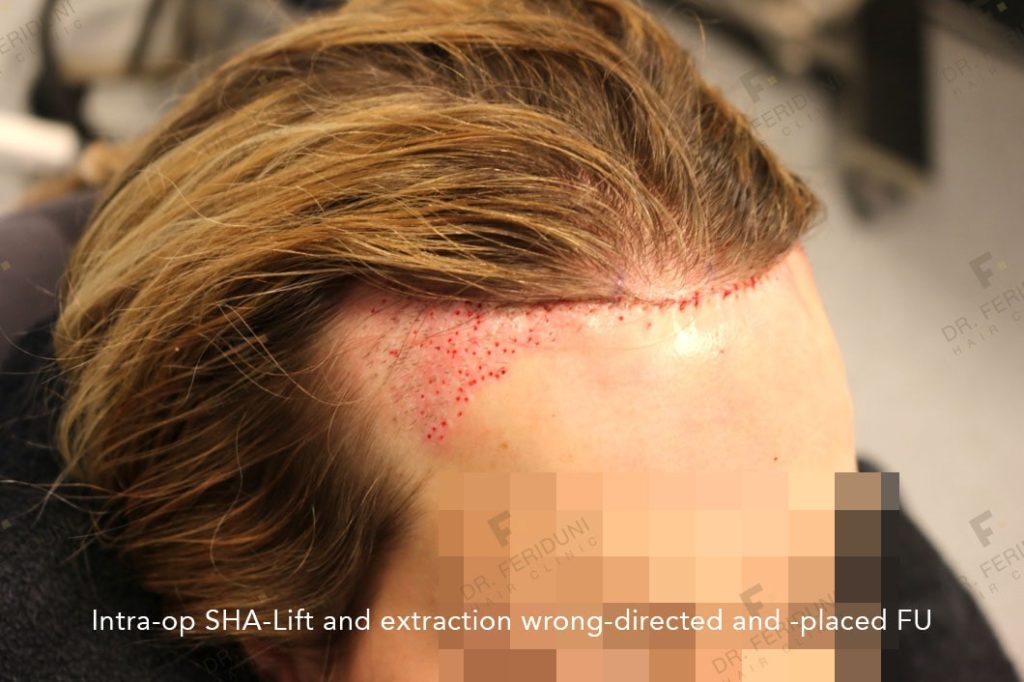
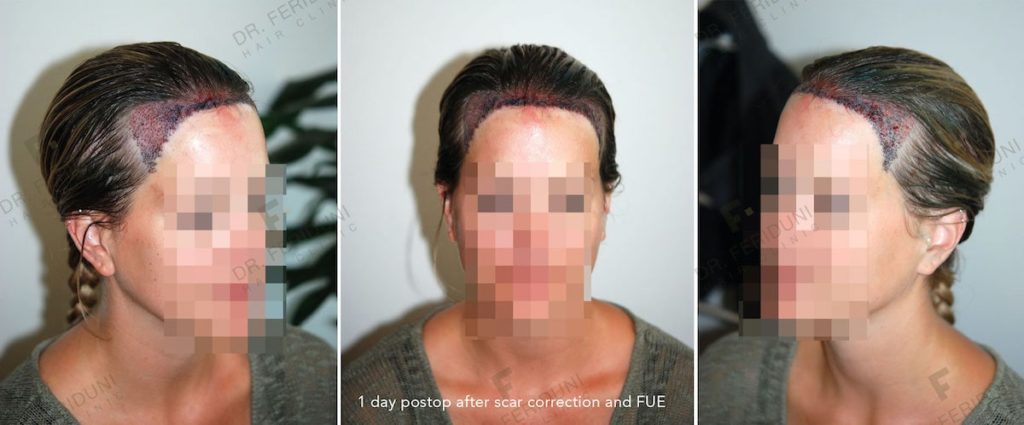
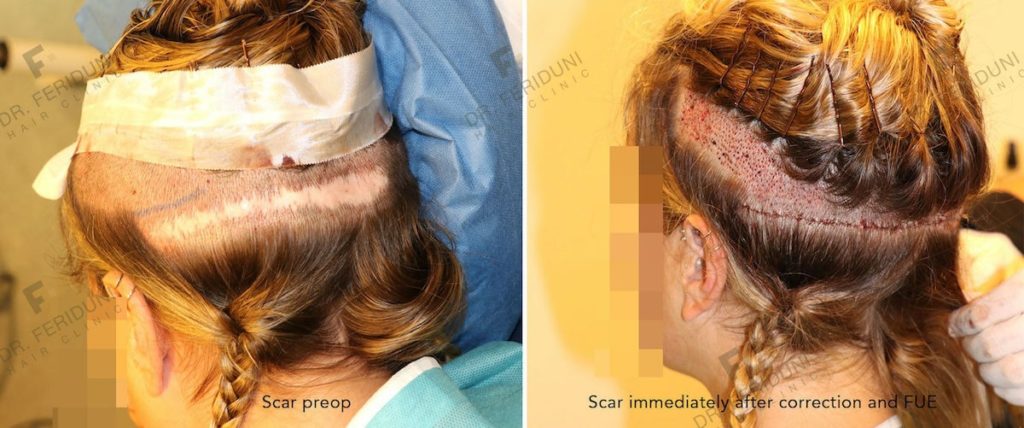
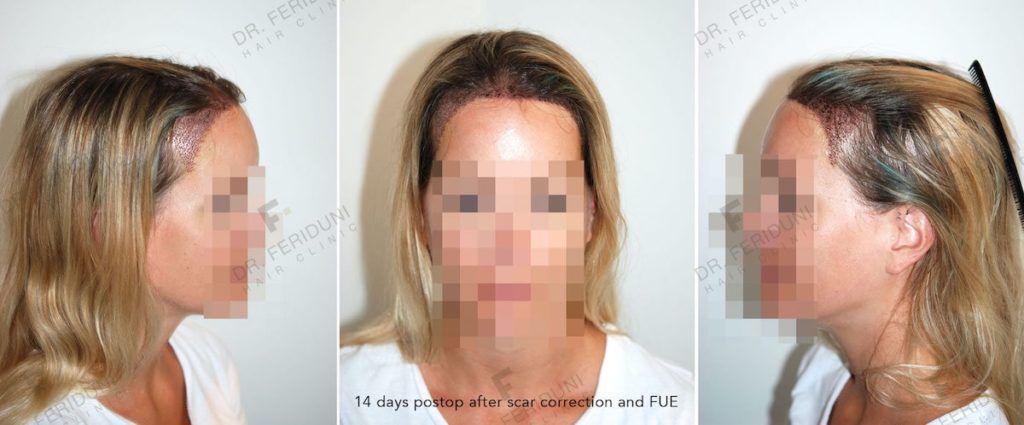
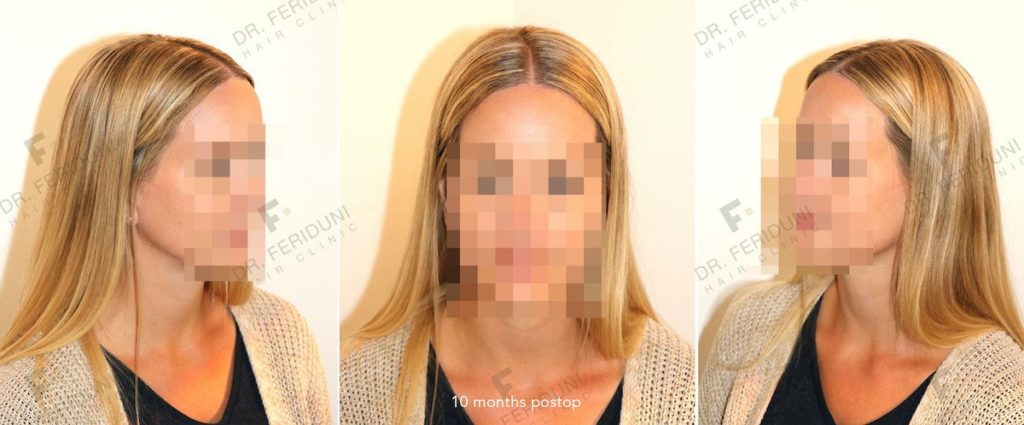

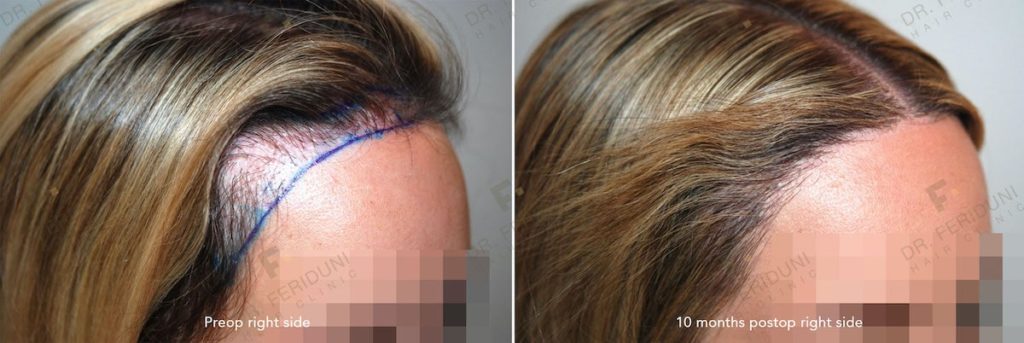
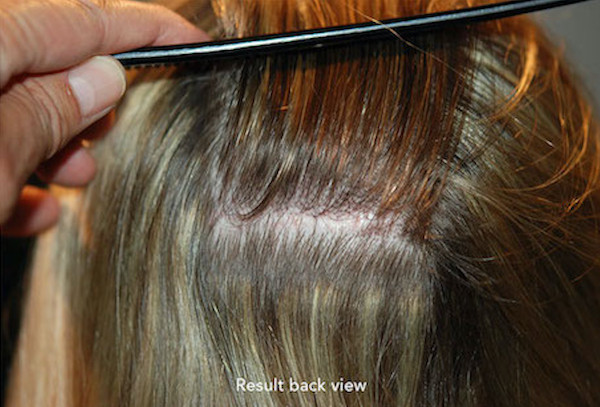

Hair transplantation women and the methods: Comparison of methods FUE and FUT
Currently, there are two techniques in hair surgery that have become the latest standards over the last few years. The main difference between them is the method of harvesting. See the following table to see which technique is best suited for a women’s hair transplant in which case (the table can be scrolled to the left and right depending on the screen resolution):
| Hair transplant women method comparison | FUT strip method | FUE hair transplantation (single hair technique) |
|---|---|---|
| Harvesting the grafts/follicular units | In the FUT technique, the hair follicles are removed in a strip of skin from the back of the head and prepared for distribution under a microscope. By surgically removing a complete strip of skin, 2000 to 4000 grafts (or significantly more, depending on the elasticity of the scalp) can be harvested at once, depending on requirements. The resulting wound at the back of the head is then surgically closed. | In the FUE technique (single extraction), the hair roots are taken individually from the donor area, isolated into grafts of 1-4/5 hair, and transplanted into the thinned out areas. Since hair roots are taken one by one, this method requires more time. Also, it is usually necessary to shave at least the donor area, which is disturbing for many women. |
| Duration of the extraction | Depending on the number of grafts, 30 minutes to 1 hour | Depending on the number of grafts and depending on the clinic and whether they are harvested manually or with a micromotor, only a few hours or spread over several days |
| Maximum number of grafts in one session | Depending on the elasticity of the scalp, the density of the hair and the size of the hairline, and also depending on the experience and size of the team of technicians, 4000-5000 grafts or even considerably more (but considerably less frequently) | Depending on the size and density of the hair ring, up to 4000 grafts or even more, but usually spread over 2-3 days by renowned hair surgeons |
| Shaving required | No in the back of the head, no in the area to be transplanted, however, depending on the hair situation, a hair surgeon may recommend shaving in the reception area during the procedure | The back of the head usually yes and the area to be transplanted usually also yes. However, there are now some hair surgeons who at least do without a shave in the recipient area and only shave the hair in the donor area. In the donor area (depending on the number of grafts), either a strip shave (often for women) or a GJ cut (rather only for men) can be performed. Meanwhile, there is also an FUE variant without any shaving, the Unshaven FUE hair transplantation, without shaving in the receiving area plus no shaving in the harvesting area. However, this method is expensive and is only performed by very few hair surgeons. |
| Who is it suitable for? | Basically for women with good scalp elasticity and patients who always wear their hair longer. In men, the minimum hair length required after FUT is 1.2 – 1.5 cm in order to sufficiently cover the linear scar, whereas women usually wear their hair much longer and this is why many still decide on FUT today, despite the linear scar. FUT is also suitable for patients with a large need for donor hair and for patients who do not like to be shaved in the hairline. | For women who cannot imagine a FUT strip hair transplantation from the point of view of the procedure, who ultimately do not prefer strip extraction and prefer a minimally invasive procedure. Women for whom shaving the donor area is OK, or patients for whom the number of grafts is still rather low, e.g. only up to 1500 grafts. In such cases, FUE Strip shaving is often still a good option. |
| Anaesthesia | Local anaesthesia always at the site of the operation | Local anaesthesia always at the site of the procedure |
| Scars | After a strip hair transplantation, a linear scar develops. The extent of the scar, the width and thickness of the scar depends on the number of grafts taken, the closure technique, the know-how and experience of the doctor and the elasticity of the scalp, as well as the healing behavior/scar tendency of the patient. If performed professionally by experienced doctors and with good conditions of the patient, scars of only 1-3 mm can remain, which still allow for quite short haircuts. For women, however, the arguments for very short haircuts are often less relevant, which is why, as mentioned above, many female patients still opt for an operation with the FUT procedure | After an FUE hair transplantation, small, fine, round scars develop which, however, are hardly visible to the human eye when removed professionally. The size and visibility of the scars depend on the know-how and experience of the doctor, as well as the type and size of the harvesting instruments used. Are the grafts removed manually or with a micro motor? If the latter, with a micro motor from which manufacturer and with which punch sizes? For women who probably don’t shave their hair 1-3 mm short anyway, the issue of scars with FUE is generally rather negligible, since, for example, with 1 cm long hair, even bad FUE grafts would probably hardly be visible. |
| Risk/Risks | Donor area: Wider scar which makes it necessary to wear the hair in the crown long (although women generally wear their hair longer). Also the risk of prolonged tightness and numbness Reception area: Poor growth rate with both methods, unnatural hairline, thick grafts, toilet brush effect, cobblestoning, and pitting More on this in the chapter Risk/Risks | Donor area: Decimated hair crown and “overharvesting”, moth-eaten and football field appearance. As a consequence, this not only brings visual and aesthetic damage but also ruins the graft reserves in the donor area, with no options for the future. In women, even bad FUE harvesting and overharvesting by very long hair are probably less visible or at least still somewhat concealable, at least not as obvious as in men, but it may be that after a bad FUE hair transplantation no further FUE procedures are possible. Recipient area: Poor growth rate with both methods, unnatural hairline, thick grafts, toilet brush effect, cobblestoning, and pitting Read more in the chapter Risk/Risks |
| When is it possible for women to do sports again after a hair transplant? | After a strip hair transplant, patients should not do any sport for at least 14 days and fitness training should ideally be avoided for 2-3 months. Otherwise, the risk increases considerably that the scar will expand and a wider scar will develop | Experience shows that after a hair transplantation with FUE, one can already start with some sports such as light jogging and cycling after 10 days |
| Temporary Shock loss | Both methods! Applies to thickening (but can also occur in adjacent areas of 1-3 cm next to the transplanted area): When women have hair transplants in areas that are still hairy, the stress of the operation, the anaesthetic etc. can cause existing hair to fall into the resting phase, which means that for 3-5 months after the hair transplant you may look slightly worse than you did before the surgery. Temporary shock loss, however, is only “temporary” and after 3-5 months, the situation will gradually improve when the growth of new hair will also slowly start. | Both methods! Applies in case of compaction (but can also occur in adjacent areas of 1-3 cm next to the transplanted area): When women have their hair thickened in areas that are still hairy, the stress of the operation, the anaesthesia etc. can cause existing hair to fall into the resting phase, which means that for 3-5 months after the hair transplant you may look somewhat worse than before the operation. Temporary shock loss, however, is only “temporary” and after 3-5 months the situation will gradually improve, when the growth of new hair slowly starts. |
| Permanent shock loss of existing hair | Both methods! Applies in case of compaction (but can also occur in adjacent areas of 1-3 cm next to the transplanted area): When women have their hair thickened in areas that are still hairy, the stress of the operation, the anaesthetic etc. can cause existing hair to fall into a resting phase, which means that 1. for 3-5 months after the hair transplantation you look slightly worse than before the operation (as with temporary shock loss), but 2. in the case of permanent shock loss, however, the hair is so traumatized by the stress of the operation, the anaesthetic etc. that they are damaged forever. The risk is all the higher the thinner the existing hair has already become due to hereditary hair loss. Unfortunately, it is not possible to predict how sensitive the already thinning hair is in the respective women and whether they will survive the operation or not. | Both methods! Applies to thickening (but can also occur in adjacent areas of 1-3 cm next to the transplanted area): When women have their hair thickened in areas that are still hairy, the stress of the operation, the anaesthetic etc. can cause existing hair to fall into the resting phase, which means that 1. for 3-5 months after the hair transplantation you look slightly worse than before the surgery(as in the case of temporary shock loss), but 2. in the case of permanent shock loss, however, the hair is so traumatized by the stress of the operation, the anaesthetic, etc. that they are damaged forever. The risk is all the higher the thinner the existing hair has already become due to hereditary hair loss. Unfortunately, it is not possible to predict how sensitive the already thinning hair is in each woman and whether or not it will survive the surgery. |
| When will women be able to socialise again after the hair transplant? | Depending on the shave, a 14-day leave of absence is generally recommended | Depending on the shave, a 14-day leave of absence is recommended for this method as well. If there is enough remaining hair and if this is not shortened and thus the cover for the traces after the surgery (redness/crusts) is possible, then it may be possible to return to work less than one week after the operation or it may even be possible to return to work one day after the operation without anyone being able to recognize a surgical intervention (for example, this may be possible in the case of a receding hairline hair transplant) |
The cost of hair transplantation depends on the area and number of grafts
Ultimately, the costs and prices depend not only on the respective technique (whether > FUE or> FUT ( strip surgery) and the respective clinic, but also on the necessary number of grafts, and the number of grafts depends on the following points, among others:
- What goals have I set for myself as a woman for the hair transplant?
- How high/low should my new hairline be?
- How large is the area that is to receive new hair? Is it only a matter of receding hairlines, or is it a matter of lowering a complete hairline or even thickening larger areas?
- What density is to be achieved?
The exact number of grafts to be “transplanted” in women also depends:
- The characteristics of the donor hair (band of hair). This means the density of in the donor area, the diameter of the hair shaft, the color of the hair (the contrast between the scalp and the hair), and whether the hair is curly, wavy, or straight.
Cost examples per graft per transplant technique
Costs for FUT (strip & FUI) – depending on country and number of grafts:
From 1.80 euros per graft in countries like Cyprus, Turkey, otherwise up to 3.50 euros per graft
Prices for FUE (FUE & FUI) – depending on country and number of grafts:
From 1.95 euros per graft in countries like Cyprus, Turkey, otherwise up to 5 euros per graft per graft
Click here for a detailed article about the costs.
Hair restoration surgery for women and general questions and answers
In principle, hair transplantation is also available for women. However, the prerequisite is that genetic hair loss is present and that there is enough hair in the band of hair (donor area) so that enough donor hair can be removed and transplanted. Consequently, patients with other diagnoses of hair loss and patients with too few donor hairs (not enough hair in the donor area) cannot be treated with hair transplantation. This includes, for example, alopecia areata and diffuse hair loss.u003cbru003e
The transplanted hair will usually grow „stably“ for a lifetime! The hair follicles taken from the donor area are considered to be insensitive to inherited hair loss and after transplantation, the transplanted hair retain their genetic specifications (the insensitivity) even in their new location. They will therefore continue to grow there and not fall victim to hereditary hair loss.u003cbru003eu003cbru003eHowever, it is important to know that the scientific basis of hair transplantation is8 that the new hair from the donor area will only grow in the new area as long as it would have grown in its original place.u003cbru003eu003cbru003eTherefore, it must always be mentioned and experience also shows that the results can become thinner with age if the crown of hair also thins out with age.u003cbru003eu003cbru003eWith women and especially with surgical hair thickening through hair transplantation, it is important to mention that the result is of course even worse if other existing hair falls out. The transplanted hair remains, but if more hair falls out, the result is even weaker.u003cbru003eu003cbru003eTo prevent further hair loss, the active ingredient minoxidil is often used in women. The active ingredient finasteride, which is often used for men, is not used here u003cbru003eu003cbru003eRead also „u003ca href=u0022https://hairforlife-international.com/en/hair-loss/u0022 data-type=u0022pageu0022 data-id=u00223161u0022u003eStopping and correcting hair loss with medicines“u003c/au003e
No! As already mentioned above, a hair restoration surgery is not a hair increase, but only a hair redistribution! The amount of hair follicles to be harvested in the hair ring is limited. Therefore, every reputable hair surgeon will handle the available donor grafts as carefully and economically as possible, even in women!u003cbru003eu003cbru003ePlaces that are important for the optical appearance, such as the front areas with the hairline, are planted more densely and other areas are given less density. In the end, a hair transplant is always only an illusion of significantly more hair than is actually present on the head!u003cbru003eu003cbru003eThis fact is especially important to mention in the case of a female hair transplant, because many women long for an increase in the total volume of their hair! However, the total volume of the hair does not increase, but the hair is only redistributed and thinner areas can be thickened.u003cbru003eu003cbru003eThe situation is different if women are not affected by hereditary hair loss and, for example, only have a high forehead. Since in many cases, in contrast to men, it cannot be assumed that a full bald head will be achieved at some point, the planning with regard to the density to be transplanted during hair transplantation can also be designed much more aggressively than with men, or fewer donor reserves can be planned as with the male sex.
Women who have already had a hair transplant describe it as a similar experience to going to the dentist. Before the hair transplant, you will always receive a local anaesthetic in the treated areas. The incisions are made carefully and are easily tolerated. After the operation, women may also experience soreness and feelings of tension and numbness. However, the pain can be managed well with mild painkillers and the feelings of tension and numbness gradually improve until they have completely disappeared.u003cbru003e
u003cbru003e– 4-5 days before the operation you should abstain from all alcohol consumption as well as from coffee on the day of the surgery.u003cbru003eu003cbru003e– 7 days before the hair transplantation you should refrain from u003cbru003etaking food supplements and/or drinking vitamins containing vitamin B and/or E u003cbru003eu003cbru003e– On the day of the operation it is best to wear comfortable clothing such as a shirt which does not have to be pulled over the head to be put on or taken off u003cbru003eu003cbru003e– 10 days before the operation no more medication may be taken which contains aspirin/acetylsalicylic acid, as well as no medication similar to aspirin (ibuprofen, diclofenac, etc. …). The same applies to any kind of stimulants and/or anaesthetics. However, if you have pain before the operation, the painkiller paracetamol is permitted.u003cbru003eu003cbru003e- Do you have to take medication prescribed by a doctor on a regular basis? If you have been prescribed medication against blood coagulation disorders (coumarin-containing, e.g. Marcumar), this must also be made known before the treatment and your treating general practitioner must be consultedu003cbru003eu003cbru003e-As a woman, do you use hair loss remedies containing minoxidil, such as Regaine, Regain, Rogaine, Lipoxidil? Please discontinue these 7 days before the surgery
After the hair transplant, women may also experience slight, sometimes considerable swelling in the area of the receiving area or in the surrounding area. After about 2-3 days, these may also appear on the face. All in all, perhaps similar to a boxer after a fight. There is usually no pain, but many patients feel disfigured and therefore avoid the company of others until the swellings have subsided (after about 5-7 days). In order to support a complication-free, optimal healing after a hair transplant, female patients should avoid heavy work/domestic work, sweating, dust, and moisture as well as sports for a period of 2-3 weeks.u003cbru003eu003cbru003eYou should wait about 4 weeks before you resume wearing a toupee, going to the sauna, swimming (with regard to chlorine), and strong sun exposure (also solarium use). For women who like to dye their hair, you should also refrain from dyeing your hair for 4 weeks after a transplant.
Yes, even after a hair transplant in women, the transplanted hairs first fall into a resting phase until they start to grow after 3-5 months. The areas that were actually planted are then empty again for a few weeks/months until they gradually become hairy again.
About 1-2 days after the hair transplantation, painless but unattractive swellings often develop in women as well, which are visible in the face through a puffy appearance and cause an overall feeling of discomfort. About 5 days after the procedure, the swellings have subsided to the extent that nothing unusual is noticed by third parties (in some cases this can take up to 3 weeks).u003cbru003eu003cbru003eAfter the operation, crusts appear on the treated areas, but they disappear after about 10 days. Many women therefore plan a holiday for this period and usually manage with 2 weeks. After the crusts have fallen off, the scalp in the corners of the receding hairline appears pink to red, which is familiar from other healed wounds. It can take up to 2-3 months for the skin to adapt to the color of the rest of the scalp. For female patients, a cosmetic concealer or make-up that does not clog the pores can help.u003cbru003eu003cbru003eImportant and especially for women who have undergone surgical hair thickening through a hair transplant. If new hair (grafts) is transplanted in the midst of existing residual hair, or in peripheral areas such as 1 – 3 cm next to the transplanted receding hairline, the overall appearance of the hairstyle can still give an unattractive impression for about 3-5 months. On the one hand, due to the slight color deviations of the skin and on the other hand, because the residual hair goes into a resting phase due to the so-called u0022shock fall-outu0022. It can take up to 3-5 months until the remaining hair starts to grow after this resting phase and also the new, transplanted hair. Consequently, a rather worse hair situation is to be expected for this period of time.
This is understandably one of the most frequently asked questions. No, the hair does not necessarily have to be shaved for a hair transplant in women!u003cbru003eu003cbru003eIn principle, many women still decide in favor of a u003ca href=u0022https://hairforlife-international.com/en/hair-transplant/fut-strip-hair-transplant/u0022 data-type=u0022pageu0022 data-id=u00222338u0022u003ehair transplant with the FUT strip methodu003c/au003e, as shaving is usually not necessary in the recipient area as well as in the donor area and a linear scar is not noticeable due to the hair that women often wear longer and, in addition, an operation with the FUT technique is often significantly cheaper.u003cbru003eu003cbru003eWith the u003ca href=u0022https://hairforlife-international.com/en/hair-transplant/fue-hair-transplant/u0022 data-type=u0022pageu0022 data-id=u00222336u0022u003eFUE methodu003c/au003e, however, at least the hair in the hairline must be shaved so that the fine hollow needle (punch) of 0.8 – 1 mm in diameter can be inserted into the skin around the follicular unit and the graft can be removed. In the recipient area, hair can often be left long after consultation with the hair surgeon.u003cbru003eu003cbru003eHowever, there are hair surgeons who prefer a full shave, especially if some preventive thickening is to be done in the peripheral areas (if the remaining hair is still quite dense) and this topic should always be clarified before the operation.u003cbru003eu003cbru003eIn the meantime, however, there is also the possibility of u003ca href=u0022https://hairforlife-international.com/en/fue-hair-transplant-without-shaving/u0022 data-type=u0022postu0022 data-id=u00225240u0022u003ehair transplantation for women without any shaving, neither in the hairline nor in the recipient areau003c/au003e.u003cbru003eu003cbru003eHowever, due to the higher time expenditure and the fact that a lot of experience and know-how is required, this surgical option is only offered by very few hair surgeons.u003cbru003eu003cbru003eAlternatively, there is also the possibility of leaving the hair in the recipient area long and either completely shaving the hair in the hairline, see also a u003ca href=u0022https://hairforlife-international.com/en/hair-transplant/fue-gj-cut-part-shaves-shaving-of-stripes/u0022 data-type=u0022pageu0022 data-id=u00223020u0022u003eGJ cutu003c/au003e, or a u003ca href=u0022https://hairforlife-international.com/en/hair-transplant/fue-gj-cut-part-shaves-shaving-of-stripes/u0022 data-type=u0022pageu0022 data-id=u00223020u0022u003epartial shave/stripe shaveu003c/au003e (however, only smaller numbers of grafts can be transplanted with this).
Most patients wish to be socially acceptable again quickly after the hair transplant (for women, in particular, shaving a large area is often unthinkable).u003cbru003eu003cbru003eHowever, after consultation with the hair surgeon, the hair in the recipient area can remain long.u003cbru003eu003cbru003eThis has the advantage that if the remaining hair is still in good condition, the traces of the operation (crusts/redness) can be well covered by the unshaved hair.u003cbru003eu003cbru003eIf it is a matter of planting the corners of a receding hairline in women, or of pulling the hairline forward in the case of a high forehead due to a hair transplant, the crusts and redness can, for example, be well concealed by a pony.u003cbru003eu003cbru003eNormally, the recommended holiday period is about 14 days. But, for example, there are chances of not needing a holiday at all if the remaining hair in women is sufficient to cover the signs (if the transplanted area was not already very light and the redness and crusts will probably u0022shine throughu0022 for a long time), or if the transplanted area (with corners or pulling forward the hairlines) can cover the signs of the surgery well by wearing a pony and if, in addition, there is as little shaving in the donor area as, for example, with a partial shave/stripe shave or even with a u003ca href=u0022https://hairforlife-international.com/en/hair-transplant/fut-strip-hair-transplant/u0022 data-type=u0022pageu0022 data-id=u00222338u0022u003eFUT strip hair transplant.u003c/au003e Then you can even go back to work one day after the operation, especially after an u003ca href=u0022https://hairforlife-international.com/en/fue-hair-transplant-without-shaving/u0022 data-type=u0022postu0022 data-id=u00225240u0022u003eUnshaven hair transplant without any shaving (not in the recipient area and also not in the extraction area)u003c/au003e.

In the period of 2-6 weeks after transplanting the hair, the hair follicles first fall out again. However, this is no cause for concern: the transplanted hair suffers a lack of oxygen in the course of the treatment, falls into a resting phase, and rejects the hair.u003cbru003eu003cbru003e3 to 5 months after the female hair transplant, the first hair roots begin to develop new hair again – gradually and also at different rates, depending on the patient. Small pimples may also appear, which are caused by a new hair shaft making its way out.u003cbru003eu003cbru003e6-10 months after the grafts have been transplanted, the planted areas become increasingly dense. Even in month 11, serious positive changes can often still be seen until the final result is expected in month 12 and the receding hairline should be fully overgrown again.u003cbru003eu003cbru003eInfo:u003cbru003eu003cbru003eThere are also cases in which significant new growth only became apparent after 6-8 months, but also patients who could already make out a remarkable increase in hair and thus an astonishing optical enhancement after 3-5 months. Although these cases are the absolute exceptions, they should not go unmentioned.u003cbru003eu003cbru003e12 months after the women’s hair transplant, full growth is usually achieved, so that one can speak of the final result after 12 months. However, positive changes in the appearance can often still occur after 12 months up to 18 months after the procedure. Since here and there a few hairs still gain thickness!
Yes. Every hair surgery procedure results in scars. With the FUT technique, there is a linear scar, which, however, can be sufficiently concealed in women by their usually longer hair, and with the FUE technique, there are small, fine, round scars, which, however, are usually hardly perceived as scars by outsiders, even with short hair.u003cbru003eu003cbru003eIn spite of the linear scar, many women still opt for a u003ca href=u0022https://hairforlife-international.com/en/hair-transplant/fut-strip-hair-transplant/u0022 data-type=u0022pageu0022 data-id=u00222338u0022u003ehair surgery with the FUT strip methodu003c/au003e, because there is usually no shaving in the recipient area or in the donor area and the linear scar is not noticeable due to the often longer hair and an surgery with the FUT technique is often much cheaper.
When women have hair thickening surgery by means of hair transplantation in areas that are still hairy, some of the existing hairs may fall into the resting phase due to the stress of the operation, the anaesthesia etc., which means that for 3-5 months after the operation one may look somewhat worse than before the operation – temporary shock loss.u003cbru003eu003cbru003eTemporary shock loss is only u0022temporaryu0022 and after 3-5 months, the situation will gradually get better when the growth of new hair slowly starts.u003cbru003eu003cbru003eHowever, there is also u0022permanent shock lossu0022. In contrast to temporary shock loss, the existing hair is so traumatized by the stress of the surgery, the anaesthetic etc. that they are damaged forever.u003cbru003eu003cbru003eThe risk is also higher in women the thinner the existing hair has already become due to hereditary hair loss. Unfortunately, it is not possible to predict how sensitive hair that has already become thinner is and whether it will survive the operation or not. Basically, it can be said that permanent shock loss is rare, but unfortunately, it cannot be ruled out!u003cbru003eu003cbru003eInfo: Temporary as well as permanent shock loss can also occur 1-3 cm next to the transplanted area in a female hair transplant.
No. Unfortunately, the costs for a female hair transplant are not usually covered by health insurance.
Lorem ipsum dolor sit amet, consectetur adipiscing elit, sed do eiusmod tempor incididunt ut labore et dolore magna aliqua. Ut enim ad minim veniam, quis nostrud exercitation ullamco laboris nisi ut aliquip ex ea commodo consequat.
Lorem ipsum dolor sit amet, consectetur adipiscing elit, sed do eiusmod tempor incididunt ut labore et dolore magna aliqua. Ut enim ad minim veniam, quis nostrud exercitation ullamco laboris nisi ut aliquip ex ea commodo consequat.
More examples of female hair transplantation
Before and after pictures

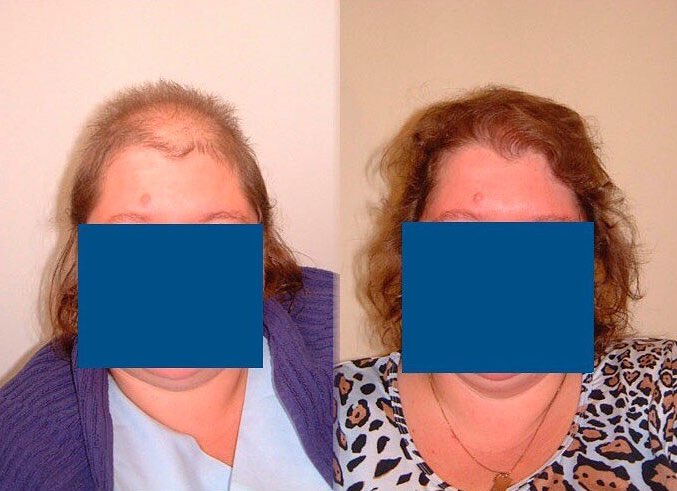

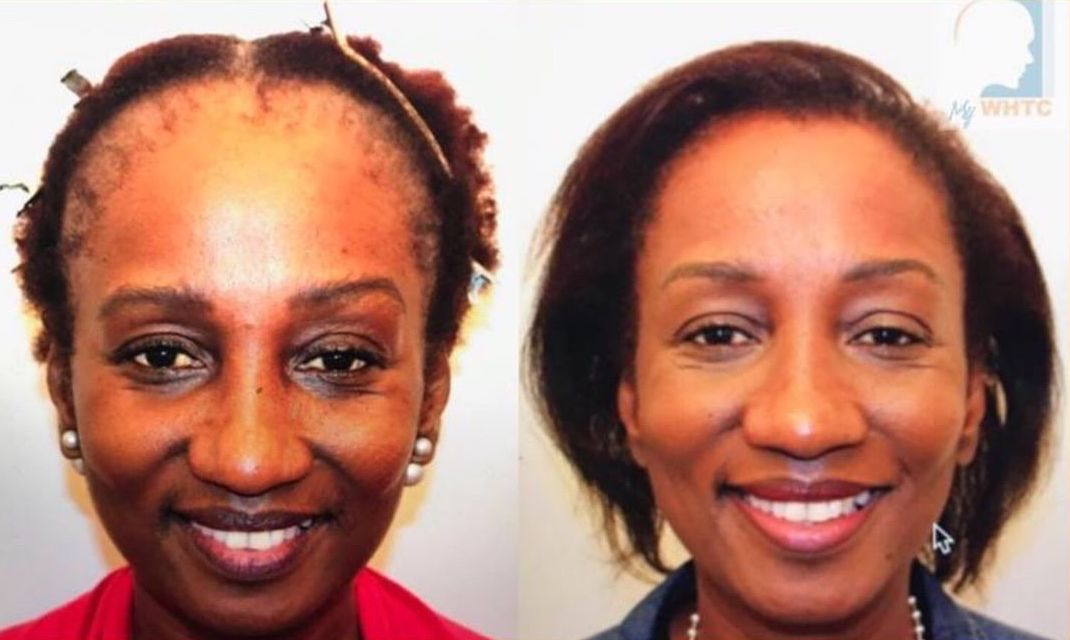
Hair transplant women before and after videos
Example: Female client with 1982 grafts transplanted into hairline and high forehead by Dr. Bijan Feriduni
Hair transplant women second example: 2044 grafts in the high forehead by Hairclinic Feriduni
Third example of a hair transplant in an African female patient with a high forehead and 2744 grafts by Dr. Patrick Mwamba
Fourth example: This patient has a total of 1715 grafts transplanted by Hattingenhair.
Sources/References/Author/Co-Authors
3 ISHRS Practice Census Results Published 2020
4 HRN: Repair Dr. Feriduni SHL Lift, Scar Correction and FUE in 2 sessions
5 https://www.ishrs-htforum.org/content/23/1/12
6 https://pubmed.ncbi.nlm.nih.gov/19289679
7 https://www.ishrs-htforum.org/content/22/6/213
8 https://www.ncbi.nlm.nih.gov/pmc/articles/PMC2825128/
Author
Andreas Krämer/Hairforlife Expert Editorial Team
Co-authors/sources (pictures/videos/information)/review
Many thanks to Dr. Bijan Feriduni, Dr. Patrick Mwamba and the Hairlineclinic for the close cooperation!


